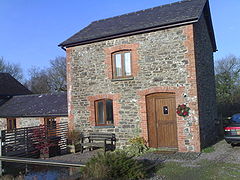- Chittlehampton
-
Coordinates: 51°01′00″N 3°57′00″W / 51.016667°N 3.95°W
Chittlehampton 
Cider barn at Lerwill Farm
 Chittlehampton shown within Devon
Chittlehampton shown within DevonPopulation 820 (2001) OS grid reference SS6325 Parish Chittlehampton District North Devon Shire county Devon Region South West Country England Sovereign state United Kingdom Post town UMBERLEIGH Postcode district EX37 Dialling code 01769 Police Devon and Cornwall Fire Devon and Somerset Ambulance South Western EU Parliament South West England UK Parliament North Devon List of places: UK • England • Devon Chittlehampton is a village and civil parish in the North Devon district of Devon in England. According to the 2001 census, the parish had a population of 820.[1]
The parish originally included two exclaves; Chittlehamholt to the south (now a parish in itself), and part of the modern parish of East and West Buckland. It now includes Chittlehampton, Umberleigh, Furze, Stowford and some other outlying hamlets. The village was the site of limestone quarries which supplied many of the county's lime kilns.
Contents
Parish Church
Chittlehampton is the home of St. Hieritha's Church and holy well. Until the 16th century many people made pilgrimages to Chittlehampton to visit the well. Today, campanologists travel from far and wide to play the famous bells in the tower of St Hieritha's church. The church is large and of the late Perpendicular period. St Hieritha is said to have been buried under part of the church. She was a saint of the 7th century.[2]
Saint Urith's holy well still stands at the east end of Chittlehampton, now called by the corrupt name of Taddy Well or Saint Teara's Well. The exact burial place of Saint Urith was probably in the small chapel on the north side of the sanctuary of the parish church, which originally contained an image of the saint. This chapel now doubles as a passage leading to a vestry. There is reason to believe that a medieval slab there may still cover Saint Urith's body. There was a regular pilgrimage to her shrine on her feast day, 8 July, until 1539. Offerings left there were sufficient to rebuild the church tower, reputedly the finest in Devon. Even in the last year of pilgrimages, the vicar received £50 from his share of the offerings. This was three times his income from tithes and glebe. By 1540 the saint's statue had been removed from the church, leading to the further loss of £50 in offerings. The pulpit of the church, carved around 1500, survives and this depicts Urith holding a martyr's palm and the foundation stone of the church. A modern statue now stands in a niche high up on the exterior of the tower and she is also shown in a stained-glass window of the 16th century found at Nettlecombe in Somerset. The pilgrimage has now been revived and villagers still celebrate the legend on her feast day, with a procession to the well. The Trinity College hymn is sung by the congregation, the well is opened and water drawn from it and blessed.
The Trinity College hymn
"Sing, Chittlehampton, sing!
Let all Devon's meadows ring with Holy Gladness for our Saint's renown,
And thou,
Blest maiden pray,
that we on this our day,
May bear our cross and win our heavenly crown".References
- ^ Office for National statistics : Census 2001 : Parish Headcounts : North Devon Retrieved 28 January 2010
- ^ Betjeman, John, ed. (1968) Collins Pocket Guide to English Parish Churches; the South. London: Collins; p. 160
External links
Ceremonial county of Devon Unitary authorities Boroughs or districts Major settlements - Ashburton
- Axminster
- Barnstaple
- Bideford
- Bovey Tracey
- Bradninch
- Brixham
- Buckfastleigh
- Budleigh Salterton
- Chagford
- Chudleigh
- Chulmleigh
- Colyton
- Crediton
- Cullompton
- Dartmouth
- Dawlish
- Exeter
- Exmouth
- Great Torrington
- Hartland
- Hatherleigh
- Holsworthy
- Honiton
- Ilfracombe
- Ivybridge
- Kingsbridge
- Kingsteignton
- Lynton
- Modbury
- Moretonhampstead
- Newton Abbot
- North Tawton
- Northam
- Okehampton
- Ottery St Mary
- Paignton
- Plymouth
- Plympton
- Princetown
- Salcombe
- Seaton
- Sidmouth
- South Molton
- Tavistock
- Teignmouth
- Tiverton
- Torquay
- Totnes
See also: List of civil parishes in Devon
Rivers Topics - Devon County Council
- Economy
- Flag
- History
- Notable people
- Dartmoor
- Exmoor
- Jurassic Coast
- Towns by population
- South West Coast Path
- Museums
Categories:- Villages in Devon
- Christian pilgrimages
Wikimedia Foundation. 2010.


